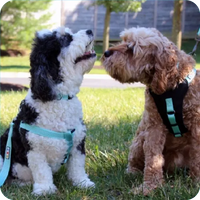FEEDING YOUR DOG RAW MEATY BONES: IS IT SAFE?
THE TREND TOWARD HOLISTIC, MORE NATURAL PET DIETS SEEMS INTUITIVELY BETTER FOR OUR PETS. BUT IS IT SAFE, AND WHAT ARE THE PROS AND CONS OF THESE RAW DIETS?
There is no easy answer to this question. The simple answer is that it depends on the dog. Many dogs thrive on a diet of raw meaty bones, but there are also numerous stories of dogs with fractured teeth from chewing hard bones. Another risk is esophageal or intestinal obstruction from eating bones and, perhaps more commonly, a nasty bout of constipation. Bones are also often high in fat and must be raw, so there is always that small risk of gastroenteritis. We will attempt to weigh the pros and cons of this debate to help you make an informed decision for your pet.
BONES FOR DENTAL HEALTH
Dental disease is a significant health problem, with 80% of pets experiencing dental disease by the time they are three years of age. Disease in the mouth does not just cause that horrendously smelly breath. Gum disease damages other organs and is a source of chronic immune stimulation. The bacteria that proliferate around diseased teeth can spread to the heart, kidneys, and liver, leading to increased illness and failure to thrive. One of the most natural ways to help keep your pet’s teeth clean is through chewing.
Pets develop periodontal disease along the gum line, so when chewing, your pet needs to be able to sink his teeth right up to the base of the tooth. This will not necessarily be the case with toys like Nylabones or Kongs. Most of your dog or cat's teeth are cutting teeth designed to tear and chew at meat and bones. Ideally, he should be eating the flesh of a large, raw, meaty bone or sinking his teeth into a raw chicken neck or wing.
Your dog (and cat) has teeth designed for different purposes, so chewing does not always help to keep those canines and incisors at the front clean. The large wedge-shaped teeth at the mouth's sides are used for tearing and cutting at meat.
DO BONES DAMAGE TEETH?
Large, hard bones can fracture teeth in some dogs. The most common fracture is of the upper 4th premolar in a dog, which is shaped a little like a pointy chisel and ideally designed for crunching bones. Large beef shin bones are strong enough to hold up the weight of a cow, so these are pretty tough bones. Many dogs can go their whole lives chewing bones like this without a problem; who knows why sometimes a painful tooth fracture occurs. Cooking bones makes them even harder, so always serve up bones raw. To limit the risk of tooth fracture, you can feed softer bones like brisket bones and raw chicken necks/wings, supervise your dog and remove the bone once the meat has gone. A bone left outside to bake in the sun will also be more complex and more inclined to cause damage.
DO BONES CAUSE GASTROENTERITIS?
Dogs are pretty savvy about saving any extra food for later, and they are known for their habit of burying that treasured bone in the yard. A bone buried in the backyard is likely to be covered in bacteria and cause a nasty bout of gastro when eaten later. You can help prevent this habit by only feeding bones when your dog is hungry and supervising bone-eating to make sure it is removed when your dog is done with it. Any bone left out for more than 4 hours will be a breeding ground for bacteria. It is estimated that modern meat has 1,000-10,000 bacterial organisms per gram, and if left out in the ‘food danger zone between 5-60°C for any length of time, these bacteria will increase to dangerous levels.
This is also where quality has a part to play. If the raw bones you feed are fresh and of good quality, they are unlikely to cause gastroenteritis. If they are smelly or old, don’t feed them. Dogs have evolved to eat raw meat and can tolerate some bacteria in their food (a suitable survival mechanism for a species inclined to scavenge all sorts of disgusting things!). However, with modern processing methods, our meat is not as fresh as it used to be. From paddock to plate, getting flesh and bones to the butcher or supermarket is prolonged, and animals are kept in intensive farming conditions. By the same token, many food safety processes are in place throughout the supply chain to ensure that meat is relatively safe. In one study of commercially available raw meat pet diets, 53%. Safety is more likely if you feed your pet human-grade flesh and bones fit for human consumption. If you wouldn’t eat it, why should your pet?
From a food safety perspective, the riskiest substances to feed raw are sausages, mince, hamburgers, fish, eggs, and chicken. While providing your dog raw chicken necks/wings for his teeth are brilliant, there is some risk of salmonella food poisoning because chickens tend to carry more pathogenic bacteria than most species of intensively farmed animals. It would help if you always weighed the risks and benefits when deciding what to feed. An older, debilitated pet prone to bouts of gastroenteritis probably shouldn’t be eating raw chicken. A young, small breed dog prone to dental disease would likely benefit from a daily raw chicken neck for his teeth.
RAW MEATY BONES AND BARF DIETS, ARE THEY BALANCED?
There is a significant revolution involving raw meat diets, with proponents claiming that dogs are ultimately carnivores and should only eat raw meat, not processed food. This debate evokes much passion, and I would like to avoid weighing in, except to say that extreme views on either side usually don’t have much research to back up their claims. Dogs have evolved to be slightly different from their ancestor, the wolf (for example, the pug).
Feeding a small toy dog a diet fit for a wolf is not necessarily the key to good health, but by the same token, many dogs do exceptionally well with diets that require more chewing and are less processed than pre-packaged dry foods. Whatever you feed, purchase the best quality that you can afford. Read the labels carefully and avoid diets full of cheap fillers like soy and corn.
Pre-prepared diets, whether of the BARF variety or regular pet foods, aim to provide all the micronutrients your pet needs in an easy-to-feed form. Most pet owners are busy enough cooking for the humans in the family, so spending extra time sourcing and preparing the variety of ingredients your pet needs to have a balanced diet is not always possible. Dogs like us should eat various nutrients, not just one type of meat for every meal.
When you think about how we eat (or should), we eat many different foods daily, not just one. BARF diets and feeding raw meaty bones are great, but ensure you meet all your pet’s nutritional needs. The key is to provide a balance of nutrients (not just one type of muscle meat) and something to chew on to keep your pet’s teeth clean.
THIAMINE DEFICIENCY
Thiamine deficiency or vitamin B1 deficiency is a big concern for pet owners feeding ‘fresh meat’ diets marketed for use in pets. The dangers have long been known in the vet industry, but unfortunately, there is a whole fridge full of mince, pet food rolls, and other meats marketed for pets in most supermarkets.
The labeling requirements for pet foods differ significantly from those for human nutrition; it is not always necessary to state the preservatives used during manufacturing. Products that contain sulfur dioxide and potassium sulfite preservatives (sulfur dioxide 220, sodium sulfite 221, sodium bisulphite 222, sodium metabisulphite 223, potassium metabisulphite 224, potassium sulphite 225 and potassium bisulphite 228) are known to cause a deficiency in thiamine, and in some cases can lead to significant neurological disease. They are not permitted in human meats due to the link with allergies in humans.
Even if these diets are mixed in with other foods, they can destroy the B1 present in the other food (even if not fed at the same time), leading to an overall deficiency. Check the labeling of any pre-prepared meat diets, and if the expiry date is longer than what you would expect for meat, it probably is too good to be true. Ideally, only feed meat fit for human consumption.
DO BONES CAUSE CONSTIPATION OR FOREIGN BODY OBSTRUCTIONS?
Theoretically, dogs are designed to digest raw bones. Cooking renders bone completely indigestible and hard. The bone pieces are more likely to form sharp fragments when chewed and can’t be broken down in the stomach like raw bones. These complex, indigestible bone fragments frequently cause constipation and require a costly and painful enema.
In some dogs, any amount of raw or cooked bone will lead to constipation, so these dogs should not be eating bones larger than chicken bones, even if they are natural. All dogs are different. Just as some can’t eat highly processed foods, some can’t eat bones without getting into trouble. If your dog is prone to constipation, adding fiber, such as grated vegetables or oat bran added, to his food can get things moving.
Other types of obstruction are simply through lack of chewing. A chicken neck is just about the right size to swallow whole in a dog the size of a kelpie. It will often get milked down the esophagus but not quite make it through the slightly narrowed area of the esophagus just above the heart.
Anything a dog chews on can cause damage to the teeth and gums and, in some more unfortunate cases, perforation through the esophageal wall or blockages further downstream. If your dog eats quickly, as though it is a race to get the food down before someone takes it away, perhaps look to feed a sizeable meaty bone that he can chew the meat off but not consume the bone itself. Alternatively, look to feed pigs ears or chunks of flesh that don’t contain bone. If you have two dogs, feeding them separately can slow down the fast-eater.
Vets often also see dogs with a piece of bone stuck between the teeth or across the roof of the mouth. If you are a dog without opposable thumbs, it is tough to remove these things. Many dogs have come in pawing at the mouth or with a foul odor emanating from the mouth for a vet to find a bone chip stuck between the back teeth. In some dogs, this can be easily removed with a pair of forceps, but for others (mainly if it is well and truly wedged), they will need general anesthesia to remove that pesky bone fragment.
FATTY BONES AND PANCREATITIS
Bones can also have a large amount of fat, leading to pancreatitis or gastroenteritis. Those hollow marrow bones in the center are essentially filled with pure fat; for dogs with a history of pancreatitis or get frequent bouts of diarrheas' after eating bones, avoid marrow bones and look for leaner bones instead. Chicken wings are also somewhat fatty if the skin is left on.
Benefits of raw meaty bones:
- Better dental health
- A more ‘natural’ diet




















Leave a comment